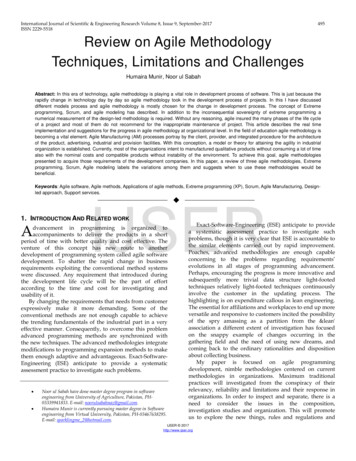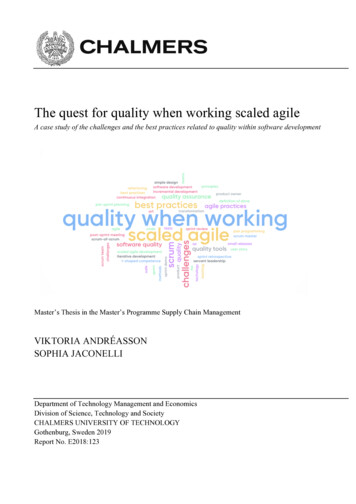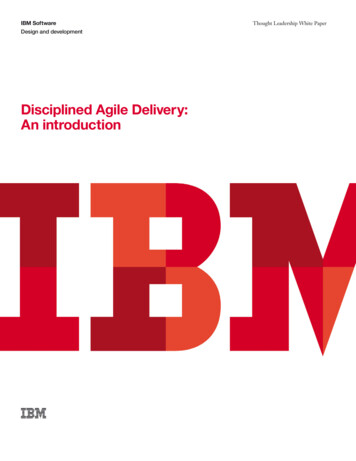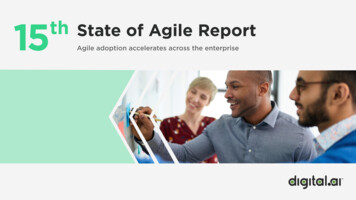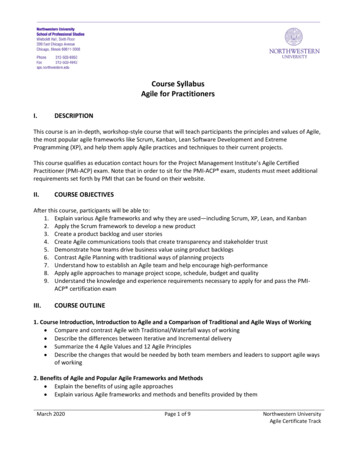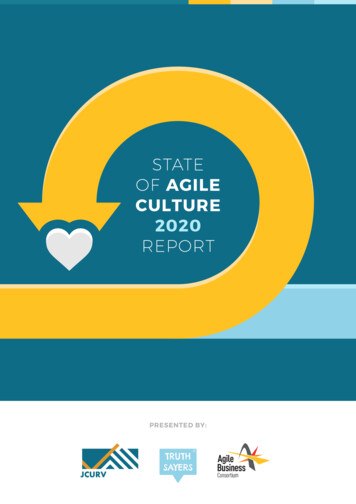
Transcription
STATEOF AGILECULTURE2020REPORTPRESENTED BY:
STATE OF AGILE CULTURE 2020 REPORTCONTENTSEXECUTIVE SUMMARY02BACKGROUND AND REPORT INTRODUCTION04SURVEY APPROACH05DEMOGRAPHICS OVERVIEW06RESEARCH HIGHLIGHTS07GLOBAL INSIGHTS12INDUSTRY14COMPANY SIZE INSIGHTS19AGILE METHODS INSIGHTS21COGNITIVE DISSONANCE23ABOUT US2501
STATE OF AGILE CULTURE 2020 REPORT02EXECUTIVE SUMMARYThe benefits of agile in organisations is widelyrecognised, yet cultural issues with its adoption stillpresent a problem. Version 1’s State of Agile Reportrevealed that 48% of organisations cite this as theirbiggest challenge to successfully implementing agile.Agile is shaped by the company set-up, the leadershipand the people, although the detail behind theseconcepts are not always readily understood. Wecommissioned this report, a world first, to examineeach of these viewpoints.We did this by surveying people in organisations –at all levels – who are dealing with this challengeevery day and uncovering what they think and feel.These are the same individuals who will deliver anagile culture.We hope our findings will enable leaders to identifyopportunities to introduce an agile culture todifferent types of organisation and to tackle thebarriers to introducing and sustaining it.Our key findings include the following:A strong agile culture improvesbusiness performance by 235%.Organisations using moresophisticated agile operatingmodels have a weaker culture.Employees prefer to workin an agile environment.Strengthening the culture takestime and commitment, but it paysoff at each stage of growth.As agile culture matures, theimportance of the individual declines,and changes to a team focus.The financial services industry hasthe strongest agile culture, while thepublic sector is one of the weakest.The reportshould make happyreading. With the clear needto focus on direction-settingand environment-building,leaders of agile organisationsare liberated from thebombardment of everydaydecisions - becausethat's what they'veempowered theirteams to do.This is a timelyand interestingreport that putsthe spotlight on thereal issues that faceorganisations as theytransition to more agileways of working. Itprovides useful evidenceof the areas to focuson to deliverbetter value.NICKY KLEIN,FORMER CHIEF DATA OFFICER,DIRECT LINE GROUPKATIE TAYLOR,VICE CHAIR,AGILE BUSINESS CONSORTIUM
STATE OF AGILE CULTURE 2020 REPORTWHY IS AGILE CULTUREIMPORTANT?03The key enablers of an agile culture are:Clear purpose and resultsThe Agile Business Consortium defines agile cultureas ‘creating an environment that is underpinned byvalues, behaviours and practices which enableorganisations, teams and individuals to be moreadaptive, flexible, innovative and resilient whendealing with complexity, uncertainty and change’.An agile culture enables organisations to focus onthe areas of greatest value to quickly release itsbenefits, learning what works while listening to theircustomers and adapting their products or servicesas customer demand shifts. It creates high levelsof trust, supports effective communication andincreases transparency throughout the organisation.Leadership role modelling agile behavioursEmployee wellbeing and fulfilmentAutonomous, collaborative teamsOperate with trust and transparencyAdaptability to changeOpenness to experimentationFrom this report,we see clearly thatfocusing on the culture is aproven route to more effectiveorganisational outcomes, in everysphere. Productivity, time tomarket, cost and risk reduction,and – most importantly –customer benefit, are allimproved in organisationswith an agileculture.We’ve supportedmore than 40organisations delivering 2.4bn worth of value byembedding agile working.The most successfultransformations sustainedthese benefits not becauseof methods and tools, but byachieving a completeshift in cultureand behaviours.JOHN WILLIAMS, CEO, THE INSTITUTEOF LEADERSHIP AND MANAGEMENTVIKRAM JAIN,MANAGING DIRECTOR, JCURVJCURV typically sees agile organisations report benefits of:40%70%25%30%21%45%Improvedproductivityin deliveryFaster timeto marketCostsavingsReducedriskIncreased customerengagementFewerunused features
STATE OF AGILE CULTURE 2020 REPORT04BACKGROUND ANDREPORT INTRODUCTIONThe report’s analysis has been based on a novelapproach to surveying, using cutting edgeneuroscience to focus on three areas: myself(employees), my company and leadership, alongwith an innovative method of capturing userfeedback. This ensured we identified key areas forimproving agile culture in organisations, whileremoving conscious bias from respondents.The aim of this report is to:Give organisations and leaders theability to identify key cultural enablersfor organisational agility.Benchmark agile capability in andacross organisations, geographiesand industries.Focusing on these three areas allowed us to identifyhow the individual, company environment andleadership interacted to enable or inhibit agility.When combined with our background data, wewere able to pinpoint striking insights into howorganisations can succeed on their agile journey.Provide insight into cultural attitudeswhich enable or inhibit success in anagile environment.Identify the challenges differentindustries and differently sizedorganisations face to enablebest practice.The survey ran from June 2020 to July 2020 andwas a collaboration between JCURV, Truthsayersand the Agile Business Consortium.ENGAGEMENT SURVEY QUESTIONSNEUROSCIENCE RESPONSELeadershipFocusing on what peoplefeel, not what they sayWays of workingEmpowermentUtilising an onlinetool to capture users’responses implicitlyClarity of purposeValue deliveryINSIGHT ACCURACYInsight that allows leaders to improve their agile cultures by.1Focusing on how teamsare feeling, not just onwhat they are saying2Identifying the keyareas of improvementfor leadership to createa thriving agile culture3Continually evaluatinghow teams are feelingand assessing theiragile maturity
STATE OF AGILE CULTURE 2020 REPORT05SURVEY APPROACHWe conducted our analysis using an advanced onlinesurveying approach which measures implicitreaction time (IRT), rather than traditional tick boxquestionnaires. IRT captures people’s immediate,intuitive, gut responses, which are often very differentfrom what they say. Unlike traditional surveys, noquestions are asked. The IRT bypasses consciousthought processes by measuring the reaction time ofhow employees respond ‘yes’ or ‘no’ to a statement.Thirty years of advances in neuroscience haveproved that emotions and feelings originate in thenon-conscious part of the brain which traditionalmethods are unable to access. Traditional box-tickingexercises make it impossible for organisations tocapture meaningful and honest data. As a result, normalemployee surveys are unable to tap into employees’true emotions and feelings, and responses can bebiased, making them ineffectual and inaccurate.When it comesto change inside anorganisation, it’s extremely rarefor everybody to be ‘all in’. Whatpeople tell their leaders about a changeinitiative is heavily nuanced and oftenvery different to how they feel. IRT isproving that transformation often failsto meet its objectives because decisionsare based on optimism, apathy,conformity or fear. Traditionaltick-box methods struggleto make that distinction.SIMON STAPLETON,CO-FOUNDER OF TRUTHSAYERSThe survey focused on three areas of cultural agility: myself, my company and leadership.The areas were further split into key components.MYSELFI am learning a lotI can experience failure without being reprimandedI am being recognised for my contributionI am clear on what we need to doI make a positive difference to our businessperformance and customersI am really enjoying my roleMy work-life balance is very goodMY COMPANYOpenly learns from its mistakesOur way of working is efficient in managing changePromotes a positive, collaborative environmentPuts its people's best ideas into actionAgile ways of working make a positive differenceto our business performanceWe have great team spiritLEADERSHIPI feel empowered by our leadershipLeaders encourage us to experiment to improveperformanceI am clear as to what the direction is of theorganisation and my teamOur leaders effectively prioritise our focus of meand my team on the highest value outcomesThe output gave us a combination of traditionalsurvey results, along with a deeper view whichreveals where cognitive dissonance occurs.
06STATE OF AGILE CULTURE 2020 REPORTDEMOGRAPHICS OVERVIEWWith 1,165 responses, the State of Agile Culture 2020 Report has beenthe year’s largest global agile survey. Our respondents come from avariety of geographies, industries, and organisations.RESPONSES1,165We analysed the data across the various splits which allowed us todraw out culturally relevant insights to help organisations on theiragile ICSPREAD10%AustralasiaSECTOR SPLITORG SIZEProfessional services19% 500Financial services17%501 - 1,000Public sector15%1,001 - 5,00022%Education10%5,001 - 20,00020%Technology8% 20,00020%Non-profit6%Retail5%Other20%SCALE OF AGILENo agile in my organisation30%8%AGILE METHOD1%Business agilityExperimenting with agile23%DevOpsUsed in discrete projects23%Scaled AgileOne or a few discrete teams10%Value stream managementUsed for major programmes29%ScrumUsed enterprise wide14%None16%3%17%3%52%9%
07STATE OF AGILE CULTURE 2020 REPORTRESEARCH HIGHLIGHTSA STRONG AGILE CULTUREIMPROVES BUSINESSPERFORMANCE BY 235%235%Our research highlights a strong relationship betweenperformance and an agile culture. Organisations which wereable to build a ‘very strong’ agile culture saw a performanceimprovement of 235%.This shows investing in agile culture will pay off in aperformance uplift, and, as John Williams notes, “There is clearevidence that organisations with an agile culture performbetter, through employee commitment not merely compliance.”Attitudes such as ‘failure being acceptable’ and ‘empowerment’emerged as key focus areas to strengthen cultural agility.Organisations that invest in building a strong agile culturecan expect an increase in business performance.TURN THE VOLUME UP ONCULTURE WHEN USINGSOPHISTICATED AGILEOPERATING MODELSOrganisations using Scrum and Scaled AgileFramework (SAFe) have the most mature agilecultures, especially in terms of leadership (seefig 1). Organisations using integratedmethodologies such as DevOps (11%) and ValueStream Management (VSM) (9%) have significantlylower levels of cultural maturity.Many organisations see VSM as a way of reducingcosts, but these more sophisticated initiatives arerarely sustainable and fail to deliver the expectedbusiness efficiencies. Organisations using theseapproaches would benefit from investing instrengthening behaviours before restructuringthe organisation.LEVELS OF CULTURALMATURITY ACROSS DIFFERENTAGILE METHODSOVERALL AGILE CULTURE MATURITY61%48%32%21%ScrumScaled AgileFrameworkDevOpsVSMOVERALL LEADERSHIP MATURITY66%47%11%9%ScrumScaled AgileFrameworkDevOpsVSMFig 1
STATE OF AGILE CULTURE 2020 REPORTEMPLOYEES PREFER TO WORKIN AN AGILE ENVIRONMENT08ENJOYMENT OF ROLE INCREASES ASAGILE CULTURE GETS STRONGERPositive perceptionEmployees’ enjoyment of their role increases withboth the strength of the agile work culture andwith their leadership exhibiting agile behaviours(see fig 2). Investment in strengthening agile culturewill pay off as employees engage more strongly withtheir company’s mission. This is essential with thechallenges imposed by Covid-19 and the increasein home working. 10Weakestagile -10culturesShelley Malton, Customer Services, Operations &Digital Director, Vodafone, says: “With remoteworking the ‘new normal’, it is even more importantthat organisations create emotional connectionwith their core purpose. Strengthening this senseof purpose helps to ensure that teams remainpassionate about going over and above for thefirm’s mission.”Strongest 10agilecultures-10Negative perceptionFig 2Enjoyment of roleTEAMS ARE WORKING HARDER, BUT ARE HAPPIER!We have seen staff report increased scores in theirability to make a difference, to learn more and toconnect more closely with their organisation’s purpose.Organisations which can leverage this will have a moremotivated, harder working workforce, who are happyto put in the extra hours to achieve the team’s goals.As organisations increase their agility and strengthentheir agile culture, work-life balance leans towards work,but employees’ enjoyment of their role increases (seefig 3). This impact on work-life balance is not necessarilya bad thing if it is compensated for by other factors.Our research indicates that people are putting more intotheir jobs because they are enjoying their work more.STRENGTH OF AGILE CULTURE AFFECTS LEARNING, ENJOYMENT,FEELING OF MAKING A DIFFERENCE AND WORK-LIFE BALANCEPositive perception 5Weakest agilecultures-10 10Strongestagile cultures-5Negative perceptionFig 3LearningEnjoymentMake differenceWork-life balance
STATE OF AGILE CULTURE 2020 REPORT09TEAMS ARE WORKING HARDER, BUT ARE HAPPIER! (CONTINUED)Some examples also show employees’ shock at therealisation that they were not working as hard usingtheir old processes. In other cases, it is due to higherengagement and thinking about work more often,driven in part by the switch to remote working.Leadership teams need to feel confident thatdeveloping an agile culture will lead to increasedengagement and they must support its development,but keep an eye on their teams’ mental health. This isvital as organisations return to work post Covid-19.CASE STUDY: BANK OF IRELANDWithin three months of introducing agile ways of working toBank of Ireland UK, team engagement levels increased by 27%.One team member commented:We are making agenuine differenceto our customers at apace we’ve not achievedbefore. It is easier tomake changes and Iam learning again!27%WORKING HARD FOR SOMETHINGWE DON'T CARE ABOUT IS CALLEDSTRESS: WORKING HARD FORSOMETHING WE LOVE ISCALLED PASSION.SIMON SINEK,AUTHOR AND TED SPEAKER
10STATE OF AGILE CULTURE 2020 REPORTSTRENGTHENING THECULTURE TAKES TIME ANDCOMMITMENT – BUT IT PAYSOFF AT EACH STAGE!There is a positive relationship between the scale ofagile use and how positively it is perceived amongindividuals, across the organisation and the leadership.This demonstrates that the greater the investment andapplication, the better the results. Katie Taylor says:“This supports the Consortium’s view that agile isnot just a set of processes but requires leaders atall levels to ‘be the change’ that inspires andsupports others.”THE STRENGTH OF AN AGILECULTURE IS IMPACTED BY THESCALE OF THE DEPLOYMENTScoreSTRENGTH OF AGILECOMPANY CULTUREScoreEnterprise deploymentUsed for major programmesUsed in discrete projectsOne or a few discrete teamsExperimenting with agileNo agileSTRENGTH OF AGILE LEADERSHIP CULTUREEnterprise deploymentOrganisations of all sizes which said they were'experimenting with agile' score low on both agileculture and leadership. This shows that early on inan agile journey, practitioners rarely have supportfrom their leaders. The data also shows that asorganisations continue to invest in agile, the culturebecomes more mature and enterprise-wide agiledeployment delivers the greatest results (see fig 4).Used for major programmesUsed in discrete projectsOne or a few discrete teamsExperimenting with agileNo agileSTRENGTH OF AGILE ‘SELF’ CULTUREEnterprise deploymentIf small-scale implementations are not having theexpected impact, organisations need to commit to thelong-term and do more rather than less. Remember,change can be challenging and achieving the benefitsrequires investment.Used for major programmesUsed in discrete projectsOne or a few discrete teamsExperimenting with agileNo agileFig 4THERE’S NO ‘I’ IN TEAM INMATURE AGILE CULTURESAs agile cultural maturity increases, the importanceof the individual’s contribution decreases.This is because in a mature agile culture, thecross-functional, self-managing team becomesjointly accountable for delivery over a specificindividual. This moves organisations from apermanent crisis mode where ‘martyrs’ step in torescue the delivery, to one where the team pullstogether and moves as a unit towards its target.Employees also prefer to work in this way(see fig 5).AS ORGANISATIONS INCREASE THEIRAGILE MATURITY, RECOGNITION OFINDIVIDUALS DECLINESPositive perception 5Smallscale agiledeployment 10Largescale agiledeployment-5Negative perceptionFig 5Individual recognition
11STATE OF AGILE CULTURE 2020 REPORTTHERE’S NO ‘I’ IN TEAM IN MATURE AGILE CULTURES (CONTINUED)Organisations which master this shift will enjoy greater employee engagement, and a culture which can seize opportunities.It can be a huge change to move from a hero-basedculture of individuals repeatedly ‘saving the day’, yet inadvertentlystarting more fires. A director at an investment bank recently confided thatmoving away from this way of working meant he struggled to know who ‘deserved’a promotion. Thankfully, as the benefits became evident, he wasable to identify the team players who were acting asagents of change and reward them instead.BEN BEAVERS, AGILE COACH, JCURVTHE STRONGEST AGILE CULTUREThe industry that scored the highest overall was financialservices. It scored particularly highly in the areas of theindividual’s perception of the culture and leadership.Financial services organisations have invested heavily in agilityover the last decade as their heavy reliance on technology hasgiven the organisations who best leverage it a competitive edge.This has been especially important for incumbents to competeagainst fintechs.The most agile organisations in financial services are embeddingagile at scale and investing in addressing the challenges associatedwith agile budgeting.LEAST MATURE AGILE CULTURESThe industries that scored lowest in agile culture weremedia, manufacturing and the public sector (see fig 6).This was felt most keenly when examining employees’engagement with their role with employees in bothmanufacturing and media responding negatively tothe statement, ‘I am really enjoying my role’.Addressing staff engagement through an agile culturecould help organisations in these sectors see similarperformance benefits to those in other industries.Applying agility has given financial services andsmaller retailers a competitive edge, making thembenchmarks for other organisations.LEAST MATURE SECTORS INTHEIR AGILE verageFig 6
STATE OF AGILE CULTURE 2020 REPORT12GLOBAL INSIGHTSWe divided the insights geographically across Europe, Asia, the Americas, Australasia and Africa and analysedthe strengths and opportunities in each region. This reveals how organisations can expect to see culturaldifferences playing into transformations when implementing agility on a global scale.CASE STUDY: LESSONS ON GLOBAL TEAMS FROM A FTSE100 BANKA global bank was embedding agile assembly teamsmade up of colleagues from different countries. TheChief Operating Officer points out: “You can’t set upand support each team in the same way as each onewill have different cultural biases.South-east Asians were used to operating withstrong hierarchies and the English teams wantedthe protection of governance groups to supportdecision-making. We had to be sensitive to specificlocal needs and not apply a one-size-fits-all approach.”OPPORTUNITIESSTRENGTHSTOP 3 AGILE CULTURAL STRENGTHS AND OPPORTUNITIES FOR EACH REGIONFig 7EUROPEAMERICASASIAAUSTRALASIAAFRICAEncouragement ofexperimentationI am clear on whatto doAgile makesa positivedifferenceto performanceI am clear onwhat we needto doI am learninga lotEnjoying myroleRecognisedfor mycontributionCompany puts itspeople’s best ideasinto actionCompany puts itspeople’s best ideasinto actionMy company putsits people’s bestideas into practiceFeelingempowered byleadersWays ofworking areefficientWork-life balanceis goodI make a positivedifference to businessperformance andcustomersI can experiencefailure withoutbeing reprimandedPromotes a positivecollaborativeenvironmentLeaders encourageus to experimentto improveperformanceI am clear aswhat to doLeaders encourageus to experimentto improveperformanceI am clear onwhat we needto doMy contributionbeing recognisedI am clear as to whatthe direction is ofthe organisationand my teamWe have a goodteam spiritI am learninga lotI make a positivedifference to ourbusiness performanceand customersHave a greatteam spiritI am empoweredby our leadersI am clear as to whatthe direction is ofthe organisationand my teamI am clear as to whatthe direction is ofthe organisationand my teamMy companypromotes a positivecollaborativeenvironment
13STATE OF AGILE CULTURE 2020 REPORTSTRENGTHS OF THE 3 CULTURAL COMPONENTS VARY ACROSS 8%Americas83%65%23%57%Asia17%48%23%29%All participants55%52%57%55%Fig 8The individual’sperception ofthe cultureThe impact theorganisation’s structurehas on the cultureThe impact ofthe leadership onbuilding the cultureIn terms of leadership behaviours, Europe is thestrongest, primarily because organisations in theregion encourage experimentation and helpemployees feel empowered.Lack of direction is also a problem in Asia and Australasia.Asia scored lowest across all three areas, and organisationsthere will need to monitor cultural change closely whenimplementing agile as it goes against the cultural norm.The Americas top the regions for both myself andcompany, but score poorly on leadership behaviours.People feel their company is supportive about whatthey should do, but their leadership does notencourage experimentation, set clear direction orempower its people.We are seeing trends around clarity across all regions,excluding Europe, both at the individual and companylevel. Business agility and Scrum scored strongly on bothclarity and leadership, so may be the best methods forthese regions. DevOps and SAFe did not score so stronglyhere, which suggests that organisations using theseframeworks need to provide strategic clarity.The geographicalinsight is a first forme, and while regionalcultural traits may be seenas barriers, a key facet of anagile culture is the ability toadapt and innovate. With thisin mind, we can find the rightstyle for the region and buildon the strengths shown, ratherthan slavishly forcing ahomogenised wayof working.I have found thatall my teams globallyhave come together well.Through our agile journey we learnedabout each other, how different partsof the team were feeling and eventhe cultural differences in howScandinavians, British, Canadians, andthe other regions work together. Theteams have all found an agile approachbenefited, and it has helpedthem collaboratemore effectively.PHIL PRINGLE,CTO, PROVIDENT FINANCIAL GROUPWILLAM MCDONNELL,GROUP CRO, RSA
14STATE OF AGILE CULTURE 2020 REPORTINDUSTRYINDUSTRIES HAVE DIFFERENT CULTURAL STRENGTHS TO LEVERAGEAND OPPORTUNITIES TO IMPROVE TO ENHANCE AN AGILE CULTUREEDUCATIONMy company openlylearns from itsmistakesCompanyMy companypromotes a positive,collaborativeenvironmentENERGY97%Our leaders effectivelyprioritise our focusLeadershipon the highestvalue outcomes85%Company95%Leaders encourageus to experimentto improveperformanceLeadership84%I am really enjoyingmy roleMyself89%I am learning a lotMyself82%13%My work-life balanceis very goodMyself0%We have greatteam spiritCompany8%15%My company openlylearns from itsmistakesCompany7%I am clear on whatwe need to doMyself30%23%I feel empoweredby our leadership96%I am clear on whatwe need to doMyselfCompany94%I am clear on whatwe need to doI am learning a lotMyself85%Leaders encourageus to experimentto improveperformanceLeadershipMyselfI make a positivedifference to ourbusiness performanceand customersMy work-life balanceis very e ways of workingmake a positiveCompanydifference to ourbusiness performance69%Company98%Leaders encourageus to experimentto improveperformanceMyself65%I can experiencefailure withoutbeing reprimandedMyself97%Leadership59%My work-life balanceis very goodMyselfCompanyI am really enjoyingmy roleLeaders encourageus to experimentto improveperformanceMyselfLeadership97%I am beingrecognised formy contributionMyself91%95%I am learning a lotMyself89%0%Our way of workingis efficient inmanaging changeCompany2%Myself0%Agile ways of workingmake a positiveCompanydifference to ourbusiness performance4%Leadership1%I feel empoweredby our leadership4%6%I am clear as to whatthe direction is ofLeadershipthe organisationand my teamI make a positivedifference to ourbusiness performanceand customersMyself11%I am really enjoyingmy roleMy work-life balanceis very goodMyself13%I feel empoweredby our leadership36%INSURANCEMy companypromotes a positive,collaborativeenvironmentMy company openlylearns from itsmistakesI am clear on whatwe need to doFINANCIAL SERVICESLeadership
15STATE OF AGILE CULTURE 2020 REPORTMEDIAMy company puts itspeople's best ideasinto actionLeaders encourageus to experimentto improveperformanceCompanyLeadershipOur leaders effectivelyprioritise our focusLeadershipon the highestvalue outcomesNON-PROFIT98%I am really enjoyingmy roleMyself94%My work-life balanceis very good97%My companypromotes a positive,collaborativeenvironmentCompany91%I feel empoweredby our leadership91%I make a positivedifference to ourbusiness performanceand customersMyself89%CompanyI am clear on whatwe need to doMyself1%My company puts itspeople's best ideasinto actionI am learning a lotMyself3%I am beingrecognised formy contributionCompany5%We have greatteam spiritOur way of workingis efficient inmanaging changeRETAILTECHNOLOGYMyself96%Leadership94%We have greatteam spiritCompany85%1%My companypromotes a I make a positivedifference to ourbusiness performanceand customersMyself4%Company16%Agile ways of workingmake a positiveCompanydifference to ourbusiness performanceHEALTHCARE AND PHARMA35%PROFESSIONAL SERVICESAgile ways of workingmake a positiveCompanydifference to ourbusiness performance92%Agile ways of workingmake a positiveCompanydifference to ourbusiness performance99%Agile ways of workingmake a positiveCompanydifference to ourbusiness performance83%I make a positivedifference to ourbusiness performanceand customersMyself87%Our leaders effectivelyprioritise our focusLeadershipon the highestvalue outcomes97%I am clear on whatwe need to doMyself81%Company87%Our way of workingis efficient inmanaging change96%I am really enjoyingmy roleMyself78%Myself16%I am really enjoyingmy roleMyself1%My companypromotes a positive,collaborativeenvironmentCompany11%My companypromotes a positive,collaborativeenvironmentCompany17%I am beingrecognised formy contributionMyself3%My work-life balanceis very goodMyself19%Our way of workingis efficient inmanaging changeCompany26%My company puts itspeople's best ideasinto actionCompany4%I am beingrecognised formy contributionMyself37%We have greatteam spiritI am clear on whatwe need to doFig 9Company
16STATE OF AGILE CULTURE 2020 REPORTSTRENGTHS OF THE 3 CULTURAL COMPONENTS VARY ACROSS 7%61%57%Public l care and pharmaceuticals38%36%67%47%Professional services56%55%62%58%Other82%66%18%55%MediaFig 10The individual’sperception ofthe cultureThe impact theThe impact of theorganisation’s structureleadership onhas on the culturebuilding the cultureFINANCIAL SERVICES SHOWS STRONGEST AGILE LEADERSHIPAcross all the industries surveyed, financial servicestopped the scores for agile leadership (see fig 11).This skillset has been honed by many banks deliveringsignificant agile transformations. In particular, the arrivalof challenger banks forced a greater focus on customercentricity and product innovation. Banks have beenworking with agile for a long time and other industries,particularly insurance, should look to them for inspiration.Within the industry, performance varied betweendifferent sizes of organisation: those with 501-5,000staff had the strongest agile leadership, and the largestorganisations (20,000 ) had the weakest. This made aninteresting contrast with insurance companies wherewe found that the largest organisations (20,000 staff)demonstrated the strongest agile leadership.FINANCIAL SERVICES HAVE A STRONGER CULTURE THAN MOST INDUSTRIES,BUT ARE WEAKER IN CLARITY AND TEAM SPIRITSTRENGTHSOverallAgile leadershipFINANCIAL SERVICESAVERAGE71%80%55%57%35%15%51%42%AREAS OF IMPROVEMENTClarity on what I need to doWe have great team spiritFig 11
STATE OF AGILE CULTURE 2020 REPORT17PUBLIC SECTOR HAS A WEAK AGILE CULTUREPublic sector scores poorly with agile culture. Employees are unclear abouttheir role, they do not feel their work is recognised or that they are making adifference to the citizens they serve. They also feel that their leadership doesnot prioritise or empower them. Unsurprisingly, this impacts strongly onemployee engagement. (see fig 12)PUBLIC SECTOR SCORES LOWER ON AGILE CULTURE THAN THE INDUSTRY AVERAGEPUBLIC SECTORAVERAGE8%51%Make a positive difference to our customers18%54%Leadership prioritisation32%57%Empowered by our leadership39%60%Recognised for my contribution23%41%I am clear on what I need to doDavid Kershaw, Agile Procurement Thought Leader,CURSHAW, explains: “The public sector is one of theleast agile of sectors globally and over-protectionof the public purse causes:Fig 12To correct this, public sector procurementteams need to:1Design processes around users, includingbidders and contractual suppliers.2Become fully embedded with users ofprocurement services and become partof a multi-disciplinary project team.3Use minimum viable procurement
Scaled Agile Framework 11% DevOps 9% VSM TURN THE VOLUME UP ON CULTURE WHEN USING SOPHISTICATED AGILE OPERATING MODELS Organisations using Scrum and Scaled Agile Framework (SAFe) have the most mature agile cultures, especially in terms of leadership (see fig 1). Organisations using integrated


